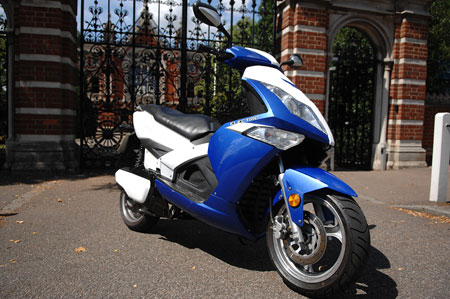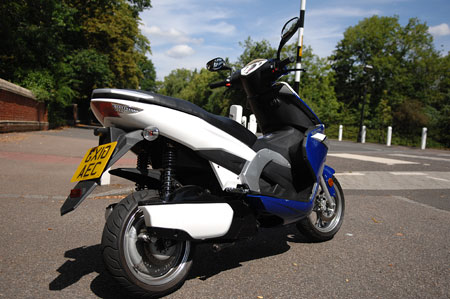|
 Electric vehicles of any type have a pretty mixed perception. On the one hand, even those of us who are less than convinced about the evils of man made climate change have to recognise that something which will reduce emissions, especially in town, has to be a good thing on balance. Even if in reality it's just shifting those emissions somewhere else. Or giving our grandchildren a bigger and better headache, of a spent nuclear fuel variety, than they will currently have. We'll ignore the rather nasty processes involved with making the batteries (or disposing of them) for now. But the good things are counterbalanced by a couple of real downers. Range and cost being at the top of the list. Electric vehicles of any type have a pretty mixed perception. On the one hand, even those of us who are less than convinced about the evils of man made climate change have to recognise that something which will reduce emissions, especially in town, has to be a good thing on balance. Even if in reality it's just shifting those emissions somewhere else. Or giving our grandchildren a bigger and better headache, of a spent nuclear fuel variety, than they will currently have. We'll ignore the rather nasty processes involved with making the batteries (or disposing of them) for now. But the good things are counterbalanced by a couple of real downers. Range and cost being at the top of the list.
Now a very long time ago I tested an electric motorbike. I've just looked it up, and it was in 1997. I was kind then because, well because I was new and hadn't yet developed the veneer of cynicism that seems to come with the job. But with the benefit of hindsight, the bike I tested back then was rubbish. The performance was sluggish at best, the looks were truly horrible and the range, while claimed to be fifty miles, was probably less than fifty kilometres. There was a whole lot of development work to be done, and despite being backed by (at the time) one of the largest bike retailers in Europe, the project vanished.
But the idea didn't.
The Sprint that's on test here is a very different kettle of fish. Despite being a pre-production prototype, it has the feel of something that has been properly developed and properly put together. It also looks sufficiently like a regular scooter not to exclude anyone other than the most die-hard green. In fact it behaves exactly the way you'd expect a 125cc scooter to behave. Apart from the lack of sound and the need to plug it into the mains every now and again, that is. Of course there are some little foibles and quirks. Some of them are down to it being, as I said  already, a pre-production machine. And some are simply a result of it being electric and, as such, a little different. We'll cover these differences as we get to them. For now, though, let's look at the basics. We can cover the details as we reach them. The Sprint is about the same size and weight as a regular 125 scooter. Maybe a little heavier, because it's got a lot of batteries. There's no exhaust, which is a little strange, and no filler cap. Which is stranger still. Instead there's an LED diagnostics panel giving some basic information about battery state and the like. On this early version that's all it does, though ultimately it will do rather a lot more. Other than that, though it's business as usual. A standard twist grip throttle, though no throttle cable of course. Standard controls for indicators, lights and horn. Standard brakes. Even a standard ignition key, though its function isn't quite normal. already, a pre-production machine. And some are simply a result of it being electric and, as such, a little different. We'll cover these differences as we get to them. For now, though, let's look at the basics. We can cover the details as we reach them. The Sprint is about the same size and weight as a regular 125 scooter. Maybe a little heavier, because it's got a lot of batteries. There's no exhaust, which is a little strange, and no filler cap. Which is stranger still. Instead there's an LED diagnostics panel giving some basic information about battery state and the like. On this early version that's all it does, though ultimately it will do rather a lot more. Other than that, though it's business as usual. A standard twist grip throttle, though no throttle cable of course. Standard controls for indicators, lights and horn. Standard brakes. Even a standard ignition key, though its function isn't quite normal.
Turn the ignition on and nothing whatsoever happens. Actually that's not quite true. The "fuel gauge" on the dash lights up to show how much battery charge you have. If the stand is down the the throttle remains locked out for safety, rather like the sidestand cutout on a regular bike. So kick the stand up, hop on and open the throttle. Still nothing. Just to be sure that you really mean to ride off, you need to pull the front brake on first. That enlivens the system and allows the motor to receive a big dollop of current from the batteries when you open the taps. But we're getting ahead of ourselves. There's another switch to think about as well. The mode switch on the right bar, very much like that on, say, a GSX-R, does exactly the same thing. It has a high and low power setting. High power biases response toward performance while low power improves range. So let's pop it into high and go for a ride.
 Having gone through the rigmarole of starting, riding is very, very normal. Open the throttle and yes, you get some acceleration. Open the throttle aggressively and you get some pretty impressive acceleration. If the speedo is even vaguely accurate then this thing will kill a 200cc scooter off the lights, no problem. And most mid range performance cars, too. An all without making a sound. Which is kind of weird. The Sprint feels heavier and more solid than most scooters of this size, probably because it actually is heavier. Battery technology hasn't quite got there yet, and though the Lithium cells fitted are massively better than previous generations. And of course they'll keep getting better. Anyway. Brakes are perfectly adequate for the available performance, though the lack of an ABS option may put some of the target market off a little. Handling is, again, much as you'd expect for a small wheel scooter. It's quick to turn and quite nicely flickable but prone to twitching over potholes and bumps - an inevitable result of the tiny wheels. Having gone through the rigmarole of starting, riding is very, very normal. Open the throttle and yes, you get some acceleration. Open the throttle aggressively and you get some pretty impressive acceleration. If the speedo is even vaguely accurate then this thing will kill a 200cc scooter off the lights, no problem. And most mid range performance cars, too. An all without making a sound. Which is kind of weird. The Sprint feels heavier and more solid than most scooters of this size, probably because it actually is heavier. Battery technology hasn't quite got there yet, and though the Lithium cells fitted are massively better than previous generations. And of course they'll keep getting better. Anyway. Brakes are perfectly adequate for the available performance, though the lack of an ABS option may put some of the target market off a little. Handling is, again, much as you'd expect for a small wheel scooter. It's quick to turn and quite nicely flickable but prone to twitching over potholes and bumps - an inevitable result of the tiny wheels.
But I suspect you're not really interested in that. A scooter does what a scooter is. You want to know about the different stuff. And you want me to tell you that it's rubbish and will never replace the internal combustion engine. Sorry, but a lot of what is coming up will disappoint you, then.
The Sprint is actually very capable. Performance really is quite sprightly and the motor pulls brilliantly. Because electric motors have no torque curve at all. If the motor is turning then it is developing maximum torque. Which makes for the lightning getaways I mentioned earlier. And of course if you can get the motor to rev then you get the power as well. Add a responsive throttle and quite nice handling with reasonable brakes and you've got something which, dynamically at least, is just about ideal for urban riding. Heck, it's even got room to leave your lid under the seat when you arrive. If you work somewhere you can wear jeans or chinos then Draggin' or Bulletproof clothing will mean that you don't even have to get changed when you get there. Which is pretty handy.
But the biggest issue that you're expecting is probably range. And that's still the Achilles' heel of electric bikes. The Sprint will allegedly do sixty miles before you have to plug it in (or push) but I feel that's optimistic. Part charged and ridden with a degree of enthusiasm on a very hot day with lots of hills I got into trouble at just under twenty miles. Had I been sensible and charged it first I reckon I'd have got twice that. So if you live in the suburbs you could easily commute into town and have a reasonable chance of getting home on the same charge. But charging isn't a chore anyway. The charger itself is built in. All you need to do is plug in a standard kettle lead under the seat and connect it to a domestic mains socket. Then leave it for something over four hours and you're ready to ride again. Plus you've got regenerative braking, which uses the bike's kinetic energy to recharge the battery when you roll off. On this pre-production bike that caused the occasional hiccup so I had it on its lowest setting, but the finished model will have a much more effective regen system that should add to the range. So while it's nowhere near as bad as you probably expected, you're going to go further, and refuel quicker, with a petrol scooter.
 But. But.
The Sprint has virtually no ongoing costs. Service intervals are immense, and will generally coincide with battery replacement and motor upgrades so as well as the chassis getting a going over you'll get the latest control software and any new benefits coming out on the latest version, so your Sprint will always be up to date. Your tyres will last forever, there's no chain or oil. No air filter or silencer to get clogged. No clutch or rollers. And, of course, no petrol. Of course you still have to pay for electricity unless you always charge it at work, but it works out at under a penny per mile to run. Including tax. The two year warranty is quite respectable, too.
The Sprint isn't quite there yet. It's expensive for a scooter, though ongoing costs are minimal, and the range isn't really good enough. But if you're looking for an economical commuter bike then this is certainly worth some serious thought.
STOP PRESS.... We've just been advised from the importer that the software has been revised on the production bikes, giving significantly (like by around 25%) improved performance. On top of that, there are new batteries giving more power for longer, the regenerative braking software has been improved with more modes added, the rear shock has been updated and the indicators have been replaced with LEDs for reduced power consumption and improved reliability.
SB
|